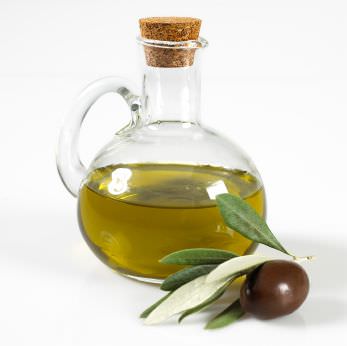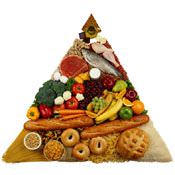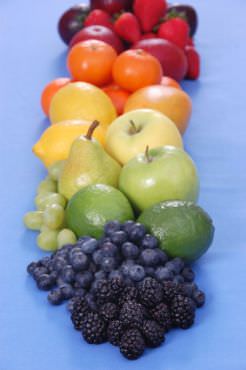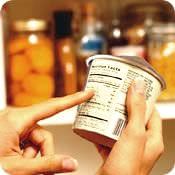
Tanya earned her dietetics degree, completed a dietetic internship and served as a clinical dietitian in several Cincinnati hospitals. With more than 20 years of nutrition education experience, she is also a member of the American Association of Diabetes Educators.![]()
Read More of 's Blogs:

New 2010 Dietary Guideline Report
Thirteen independent experts have finally concluded their work and presented their Report on Dietary Guidelines for Americans, 2010. The 2010 Advisory Committee worked for two years to update the guidelines and the group consists of individuals nationally recognized for their knowledge in the fields of nutrition or health and are affiliated with universities throughout the country. Their initial task was to "provide science-based advice for Americans, in order to promote health and to reduce the risk for major chronic diseases through diet and physical activity." The report recognizes that we have an overweight and obese American population that is already dealing with chronic diseases instead of predominantly healthy individuals that are seeking to maintain health, which was the original intention of the guidelines when they were first introduced in back in 1980.
Congress mandates the Dietary Guidelines be reviewed and updated every five years by the United States Department of Agriculture (USDA) and the Department of Health and Human Services (HHS). The guidelines provide the basis for federal nutrition education, food assistance programs, and decisions about national health objectives. These new updated guidelines will be used as the basis for meal planning for the National School Lunch Program as well as the Elderly Nutrition Program. The Special Supplemental Nutrition Program for Women, Infants, and Children (WIC) incorporate the guidelines into their educational materials while the Healthy People 2010 objectives for the Nation will include the developed 2010 Dietary Guidelines. The updated guidelines will be used to "help policy makers, educators, clinicians, and others speak with one voice on nutrition and health to reduce the confusion caused by mixed messages in the media." Here are some highlights of the updated guidelines and how you can provide feedback before the guidelines are approved and published later this year.
Posted 6/17/2010 1:00:00 PM By: : 42 comments 24,248 views

A Grand Opportunity for Alzheimer's Disease
Ronald Reagan, Charlton Heston, Rita Hayworth, and Mary Ellen Westerman are all people that had one thing in common. The first three names are people that were important to the world in one way or another but the last was someone that was important to me. Mary Ellen Westerman was my grandmother and although she was physically healthy when she turned eighty, like millions of other people she battled a degenerative disease of the brain.
This degenerative brain disease is known as Alzheimer's and it causes a gradual loss of memory, judgment, and ultimately the total ability to function. As was the case with my grandmother, dementia typically appears in older people as subtle forgetfulness that worsens and limits their ability to function normally in many aspects of daily life. Familiar settings become confusing, memories focus on places and experiences from many years before, and routine tasks turn into a challenge. The decline of my grandmother stood in stark contrast to my then newborn son. As he was learning to walk, talk, and feed himself, she was losing her ability to do the same. Eventually like most others, she required total care during her advanced stages of the disease before losing the battle due to general body wasting. It is estimated that about 5.3 million people in the United States have Alzheimer's disease. Unfortunately for my family, not only does the risk of contracting the disease go up as we get older, it is also higher if a family member has had the disease. Since my husband also lost his grandmother to the same disease, I suppose the race is on to see which of us forgets the other first.
I previously told you about a participation opportunity for the VITAL study, a research study designed to see if taking omega 3 fatty acids or vitamin D supplements could reduce the development of cancer, heart disease and strokes in healthy people. Now there is another opportunity I wanted to bring to your attention.
Posted 6/14/2010 5:28:43 AM By: : 87 comments 21,330 views

New U.S. Olive Oil Standards Are Coming
If you are a Rachael Ray fan, you are sure to know what she means when she mentions EVOO. If you consider yourself a foodie or a farmer's market junkie, references to golden-hues or peppery finishes of oil do not confuse you. For many of us, selecting olive oil is a matter of purchasing what is on sale at the time our supply runs out. As the Mediterranean way of eating has become more and more popular, so has olive oil. With the increase in popularity came the confusing marketing terms and cheap imposters passing themselves off as top quality. Last April the U.S. Department of Agriculture issued new U.S. Standards for Grades of Olive Oil and Olive-Pomace Oil which will become effective at the end of October. These new standards will update and replace the existing standards that were last issued in 1948.
Here are the highlights of the new standards to help you beat the loopholes of food labels to ensure you are buying the quality you expect.
Posted 6/10/2010 5:00:00 AM By: : 40 comments 15,699 views

Wheatgrass: Favorable or Fad?
With the recent Consumer Reports findings of metal in protein drinks, you may see new options being promoted at your local health food store. One new up and coming drink catching some buzz is wheatgrass juice.
Agropyron plants are closely related to wheat but with an appearance similar to lawn grass. The sprouted grain can be extracted and made into a powder and placed into a pill or the grass itself can be placed in a wheatgrass juicer and blended into a green milky liquid. Some people drink the bitter tasting juice straight but most frequently mix it with juice or add it to a smoothie or shake. Wheatgrass was first introduced as a nutritious option back in the 1930's with a number of unconfirmed claims that still linger today. Although in some ways wheatgrass is no different nutritionally from other vegetables, are they benefits or potential risks?
Posted 6/7/2010 6:35:46 AM By: : 68 comments 34,539 views

Heavy Metal Protein Drinks?
A Consumer Reports review in the July issue highlights their recent laboratory findings regarding protein drinks. They tested fifteen drinks using an outside laboratory and discovered some disturbing results. Since we previously provided a review of muscle milk, we thought it would be important to provide you with the recent findings so buyer can be aware.
Performance enhancing supplements remain big business and in some cases, protein supplements are beneficial to augment a balanced nutrition plan. The Consumer Reports review noted that sports nutrition product sales have exceeded $2.7 billion and protein drinks are the category leader. While they may prove beneficial in supporting some fitness goals, if there is an increased health risk when using any product, care and caution are definitely in order. The Consumer Reports review of fifteen protein drinks found increased risk of heavy metal exposure especially with significant supplement use for such metals as arsenic, cadmium, lead, and mercury.
Posted 6/3/2010 6:06:48 AM By: : 87 comments 42,714 views

You Asked: What Are The Risks of BPA?
The ongoing debate over plastic has been a hot topic for the past year. Last week I shared that BPA is not just in plastics but can also be found in metal-based food and beverage cans. A common question came up in the comments asking about the health risks of BPA so I thought it would be a good idea to follow up and provide a basic overview of the history and possible risks of BPA.
Posted 5/31/2010 1:54:51 PM By: : 49 comments 18,837 views

Does Your Past Influence Your Health Behaviors?
As I get closer and closer to sending my children out into the world on their own, I realize how much of their foundation will be carried with them when they go. As we talk about different topics, I am quickly reminded of how my foundation is still carried with me and influences how I teach and train them. As I look at the foundation we have attempted to establish for our children related to living a healthy lifestyle, I am struck by how my own upbringing and experiences have shaped my behavior and directly relate to the choices I make today.
Posted 5/27/2010 1:31:40 PM By: : 45 comments 18,091 views

BPA Is Not Just in Plastics
For nearly two years we have heard about the dangers and potential health risks of plastic bottles due to a chemical known as bisphenol A or BPA. In response to concerns regarding water bottles, baby bottles and plastic storage containers, plastic guides for smart and safe usage began to pop up to help consumers make healthy lifestyle changes to reduce BPA exposure and risk.
Now that many of us have made positive changes in plastic use, a new study reveals that over 90 percent of canned foods tested were positive for the detection of BPA. So, now what are you to do?
Posted 5/24/2010 6:04:07 AM By: : 98 comments 41,909 views

How Much Caffeine Are You Consuming?
You enjoy a cup of coffee with your breakfast, a glass of tea in the afternoon, a sports drink as you recover from your workout and a few pieces of chocolate to sooth your sweet tooth after dinner. Nearly 80 percent of people around the world consume caffeine on a daily basis. Adults in the United States and Canada consume an average of 250 mg of caffeine each day whereas those that live in Sweden and Finland consume around 400 mg per day. People in the UK enjoy caffeine in a range somewhere in between with an average daily intake around 300 mg and the average adult consumes most of their caffeine from coffee, tea, soft drinks, chocolate and medicine. The estimated intake for children is between 150-200 mg per day mostly from soft drinks, sweets, and sports drinks. Do you know how much caffeine you get in a day?
Posted 5/20/2010 12:54:27 PM By: : 146 comments 75,458 views

A More Diverse Food Pyramid
Obesity is a world problem and as of 2006, one in ten adults worldwide were considered obese. I suppose this should not be surprising since the appeal of the American diet for good and for bad has spread around the world.
For those that come to live in the U.S., learning to blend favorite foods from the country of origin with newfound American fare can be difficult. Dietitians are finding wonderful teaching assistance from reshaped food pyramids that focus on healthy eating guidelines for Asian, Latino, and Mediterranean eating preferences.
Oldways Preservation Trust is "dedicated to changing the way people eat through practical and positive programs grounded in science and tradition." Their core health promotion programs include The Whole Grains Council, The Latino Nutrition Coalition and The Mediterranean Foods Alliance. Oldways has worked with several other organizations to reshape the US Food Pyramid for other cultural eating preferences. Here are some of the differences.
Posted 5/17/2010 6:06:32 AM By: : 53 comments 58,461 views

Are You Eating a Rainbow?
It is well understood that a diet rich in fruits and vegetables provides many health benefits such as lowering blood pressure and reducing risks of heart disease, cancer, and digestive problems. Not only do they provide many necessary vitamins and minerals, but also beneficial fiber as well.
According to U.S. nutritional data, we are not measuring up when it comes to eating a variety of fruits and vegetables but tend to consume the same bland produce repeatedly. When you limit fruit and vegetable intake to only a few more common sources, you are also limiting your phytochemical intake as well. Phytochemicals are the naturally occurring non-nutritive disease preventive chemicals found in plants.
It doesn't matter whether you rely on the ROY G BIV mnemonic or need to look at a rainbow picture, as long as you focus on an intake that includes all the colors of the rainbow, you will be certain to provide your body with a wide range of nutrients. Here are some fruit and vegetable suggestions to help you eat a rainbow.
Posted 5/13/2010 5:00:00 AM By: : 83 comments 34,343 views

Can't We All Just Get Along?
Coach Nicole suggested this catchy title after listening to my small rant in the office recently about accepting people where they are and encouraging them toward where they want to be. Lately I have been bothered by the intolerance of people. Not intolerance related to religious or political views (although there is a great deal of intolerance in these areas as well) but by the intolerance of people for health and fitness goals and habits that are different from their own.
If we are all different and unique, shouldn't our lifestyle habits be as well? What if some of us are still stuck in a dieting mentality and don't even realize it? Could that be causing intolerance with others that have embraced the healthy lifestyle journey?
Posted 5/3/2010 6:50:27 AM By: : 106 comments 19,444 views

Are You Consuming Too Much Sugar?
Sugar provides such sweet memories for me. As a child growing up, my mother would often sing the Mary Poppins song A Spoonful of Sugar as she was encouraging us to do tasks and chores we did not want to do. When we had hiccups, she would offer a spoonful of the sweet white granules to suck on to help them go away.
As we seek to make healthier lifestyle choices, it is important to understand the role nutrients like sugar play in our life. Earlier this year I introduced readers to the Life's Simple 7 assessment tool by the American Heart Association designed to help people evaluate their cardiovascular health. Part of the goals of that assessment included maintaining a diet low in sugar.
A study released last week in The Journal of the American Medical Association validated the idea that high sugar consumption plays just as much of a role in heart disease risks as dietary fats. The study found a strong correlation between sugar consumption and lipid profiles. Study individuals with higher sugar consumption appeared to have lower HDL and higher triglyceride levels. These are opposite of what has been found to be protective against heart disease. Average added sugar consumption in the study was over 21 teaspoons per day, which provides over 320 additional calories to daily calorie intake. In comparison, The American Heart Association recommends women limit added sugars to less than six and a half teaspoons (25 grams) per day while men are advised to include less than nine teaspoons (37.5 grams) of added sugars. The World Health Organization suggests diets include no more than 10 percent of caloric intake from added sugars and sweeteners. If we are going to reduce our added sugar intake, perhaps we need to take a closer look to understand what they are and where they come from.
Posted 4/29/2010 5:00:00 AM By: : 182 comments 107,880 views

Will the FDA Efforts to Limit Salt be Successful?
Salt is an acquired taste and unfortunately too many of us have acquired it. Many people ask why there is so much sodium in restaurant foods and are learning that reducing salt intake is easier said than done.
Salt also known as sodium chloride has been used for generations in baked goods as a leavening and browning agent as well as assisting with product texture, structure and enhanced "mouth feel." It has seen increased use over the decades by food manufactures that utilize it as a cost effective option to extend product shelf life due to its preservative properties. One reason we may have seen more high fructose corn syrup used in shelf stable products such as breads and crackers over the years could be that it hides the unfavorable salty taste created by increased sodium-based additives used to reduce product waste from spoilage. The longer a product can safely sit on a shelf, the less loss for the company.
Last week it was reported that the FDA will begin working with the food industry and health experts to reduce processed sodium content in packaged foods over the next ten years. Here is why this may be a positive step forward.
Posted 4/26/2010 1:21:37 PM By: : 129 comments 22,656 views

Beware the New Food Marketing Hype
Understanding the loopholes of food labeling can be tricky. It requires looking beyond the fancy marketing claims to find the truth about a product. Many times when we are in a hurry we skip reading the labels and move toward purchasing a product based on name or nutrient recognition and price which is just what the marketers love.
There has been a great deal of talk about high fructose corn syrup pros and cons over the years. Now food companies such as ConAgra, Kraft Foods, and PepsiCo are taking a marketing leap into the topic as well.
Posted 4/19/2010 6:08:25 AM By: : 83 comments 22,443 views
‹ Back Read More Entries ›

.png)


